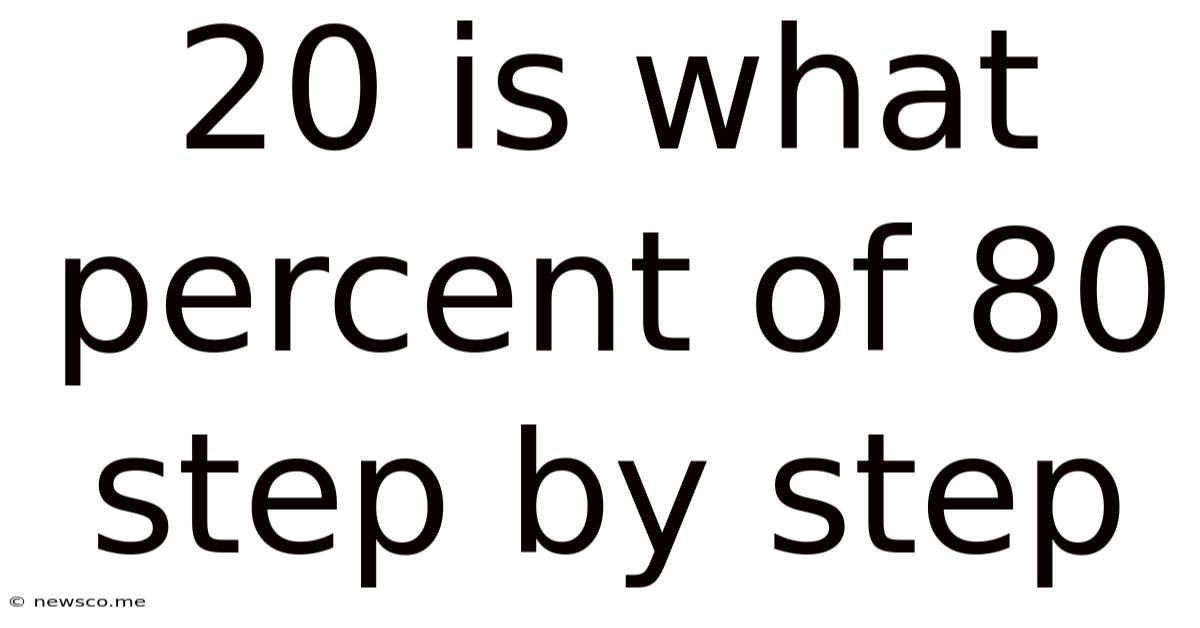20 Is What Percent Of 80 Step By Step
News Co
May 02, 2025 · 4 min read

Table of Contents
20 is What Percent of 80? A Step-by-Step Guide to Percentage Calculations
Understanding percentages is a fundamental skill in many aspects of life, from calculating discounts and taxes to analyzing data and understanding financial reports. This comprehensive guide will walk you through how to determine what percentage 20 represents of 80, explaining the process step-by-step and providing additional context to solidify your understanding of percentage calculations. We'll explore multiple methods, ensuring you grasp the core concepts and can apply them to various percentage problems.
Understanding Percentages
Before diving into the specific calculation, let's briefly review the concept of percentages. A percentage is a fraction or ratio expressed as a number out of 100. The symbol "%" is used to denote percentages. For instance, 50% means 50 out of 100, which is equivalent to ½ or 0.5.
Percentages are crucial for expressing proportions, comparing values, and illustrating changes. They are widely used in various fields, including finance, statistics, science, and everyday life.
Method 1: Using the Formula
The most straightforward method to calculate what percentage 20 is of 80 involves a simple formula:
(Part / Whole) x 100% = Percentage
In this case:
- Part: 20 (the number we want to express as a percentage)
- Whole: 80 (the total number)
Let's substitute the values into the formula:
(20 / 80) x 100% = ?
-
Division: First, divide the part (20) by the whole (80):
20 / 80 = 0.25
-
Multiplication: Next, multiply the result by 100%:
0.25 x 100% = 25%
Therefore, 20 is 25% of 80.
Method 2: Using Proportions
Another effective way to solve this problem is by setting up a proportion. A proportion is an equation stating that two ratios are equal. We can represent the problem as:
20 / 80 = x / 100
Where 'x' represents the percentage we're trying to find.
-
Cross-Multiplication: To solve for 'x', we cross-multiply:
20 * 100 = 80 * x 2000 = 80x
-
Solving for x: Divide both sides of the equation by 80:
2000 / 80 = x x = 25
Therefore, 20 is 25% of 80.
Method 3: Using Decimal Conversion
This method involves converting the fraction to a decimal and then multiplying by 100%.
-
Fraction: Express the problem as a fraction: 20/80
-
Decimal Conversion: Divide the numerator (20) by the denominator (80):
20 ÷ 80 = 0.25
-
Percentage Conversion: Multiply the decimal by 100%:
0.25 x 100% = 25%
Again, we arrive at the conclusion that 20 is 25% of 80.
Understanding the Result: Practical Applications
The fact that 20 is 25% of 80 has several practical implications. Consider these examples:
-
Discounts: If an item originally costs $80 and is discounted by 25%, the discount amount is $20, resulting in a final price of $60.
-
Sales Performance: If a salesperson had a sales target of 80 units and sold 20 units, their performance is at 25%.
-
Data Analysis: If a survey of 80 people showed 20 preferred a particular option, 25% of the respondents favored that option.
-
Financial Reporting: If a company's total revenue is $80 million and a particular product line generated $20 million, that product line contributed 25% to the total revenue.
Beyond the Basics: Solving Similar Percentage Problems
The methods outlined above are applicable to a wide range of percentage problems. To solve any percentage problem, you need to identify the "part" and the "whole". The formula (Part / Whole) x 100% remains consistent.
Example 1: What percent of 50 is 10?
(10 / 50) x 100% = 20%
Example 2: 30 is what percent of 150?
(30 / 150) x 100% = 20%
Example 3: What is 15% of 200?
(15 / 100) x 200 = 30
Tips for Mastering Percentage Calculations
-
Practice Regularly: The key to mastering percentages is consistent practice. Work through various examples, starting with simple problems and gradually increasing the complexity.
-
Understand the Concepts: Ensure you have a solid grasp of the underlying concepts of fractions, decimals, and ratios. These are all interconnected and essential for understanding percentages.
-
Use Multiple Methods: Experiment with different methods to solve percentage problems. This will help you develop a deeper understanding and choose the approach that works best for you.
-
Utilize Online Resources: There are numerous online calculators and resources available that can assist you with percentage calculations and help you check your work. These can be incredibly helpful during your learning process.
-
Real-World Applications: Try to apply percentage calculations to real-world scenarios. This will help you retain the information and understand its practical value.
Conclusion
Calculating what percentage 20 represents of 80 – which is 25% – is a straightforward process achievable through various methods. By understanding the core concepts and applying the appropriate formulas, you can confidently tackle a broad range of percentage problems. Remember to practice regularly, utilize different methods, and apply your knowledge to real-world examples to solidify your understanding and become proficient in percentage calculations. This skill is invaluable in numerous academic, professional, and personal contexts.
Latest Posts
Related Post
Thank you for visiting our website which covers about 20 Is What Percent Of 80 Step By Step . We hope the information provided has been useful to you. Feel free to contact us if you have any questions or need further assistance. See you next time and don't miss to bookmark.